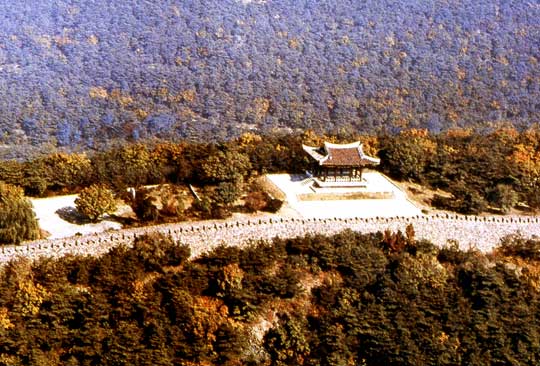Historic sites in Mt Taesong
Mt Taesong, a scenic beauty of Pyongyang, abounds with the historic sites and relics permeated with the intelligence and talents of the Korean nation.
Most of them date back to the period between the 3rd century and the mid-5th century, when Koguryo (277 BC-AD 668), the first feudal state of Korea, advanced to the Pyongyang area.
What is the most representative is the Taesongsan Fortress that was constructed around the 5th century to defend the castle of Anhak Palace after Pyongyang became the capital.
The fortress is 7 076 meters in circumference and 9 284 meters in total length, linking the peaks of Somun, Ulji, Jangsu, Pukjang, Kuksa and Jujak.
With the rugged peaks to the north and the steep slopes to the east and west of it, the fortress was consolidated with two-fold walls to the south.
More than 20 gates, 65 bastions, granaries, terraced fields, barracks and arsenals were excavated in the fortress.
At present, 200 meters-long wall stretches on Somun Peak are in their original state.
There is the site of Anhak Palace, the royal palace of Koguryo existed between 427 and 586, at the southern foot of Mt Taesong.
The castle of Anhak Palace is in a square form. It was based with stones and compacted with earth over the stones. Each side of the castle is 622 meters long and has the sites of gates.
Inside the castle there were many buildings with a total floor space of 31 458 square meters. Thousands of cornerstones of the original buildings are in their places.
Kwangbop Temple, a Buddhist hall built in 393 during the reign of King Kwanggaetho of Koguryo, is preserved in Mt Taesong. It was destroyed during the Korean War and restored to its original state in 1990.
Also found in Mt Taesong are over 1000 tombs of the Koguryo period.
Most of them are either earthen-mound tombs with stone chambers or stone-mound tombs. There are mural paintings of persons, horses, carts, tortoise and serpent, warriors on armored horseback and so on.
The historic remains in Mt Taesong are well preserved as valuable cultural heritage that demonstrate the social system, customs and daily life of the contemporary people.
